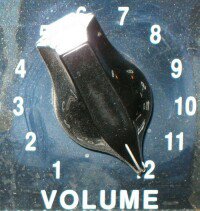
Rubber Soul is the sixth studio album by the British rock band The Beatles, released in December 1965. Produced by George Martin, Rubber Soul had been recorded in just over four weeks to make the Christmas market. Unlike the five albums that preceded it, Rubber Soul was the first Beatle album recorded during a specific period without being interrupted by tour dates (though the group's debut album Please Please Me was technically recorded in a single day, four of the tracks were recorded several months before). All of the Beatle albums after Rubber Soul (except Magical Mystery Tour) followed this process. Track list changes to the US release, including two acoustic songs held over from the previous album, Help!, gave the album a folk rock feel, which critics attributed to The Byrds and Bob Dylan. The original UK release, however, shows the "soul" influence of the album's title. The album was seen as a major artistic achievement, attaining widespread critical and commercial success, with reviewers taking note of The Beatles' developing musical vision.
McCartney conceived the album's title after overhearing a black musician's description of Mick Jagger's singing style as "plastic soul". Lennon confirmed this in a 1970 interview with Rolling Stone, stating, "That was Paul's title... meaning English soul. Just a pun."[1] McCartney said a similar phrase, "Plastic soul, man. Plastic soul...", at the end of "I'm Down" take 1, on Anthology 2.
Rubber Soul is often cited as one of the greatest albums in pop music history. In 1998, Q magazine readers voted it the 40th greatest album of all time, while in 2000 the same publication placed it at number 21 in its list of the 100 Greatest British Albums Ever.[2] In 2001, VH1 placed it at number 6.[3] In 2003, the album was ranked number 5 on Rolling Stone magazine's list of the 500 greatest albums of all time.[4] In 2006, the album was chosen by Time magazine as one of the 100 best albums of all time.[5]
Music
According to Richie Unterberger, "[The Beatles] and George Martin were beginning to expand the conventional instrumental parameters of the rock group, using a sitar on 'Norwegian Wood (This Bird Has Flown)', French-like guitar lines on 'Michelle' and 'Girl', fuzz bass on 'Think for Yourself', and a piano made to sound like a harpsichord on the instrumental break of 'In My Life'."[6]Musically, The Beatles broadened their sound, most notably with influences drawn from the contemporary folk-rock of the Byrds and Bob Dylan.[4][7] The album also saw The Beatles broadening rock 'n' roll's instrumental resources, most notably on "Norwegian Wood (This Bird Has Flown)". Although both The Yardbirds and The Kinks had used Indian influences in their music, this track is generally credited as being the first pop recording to use an actual sitar, an Indian stringed instrument, and "Norwegian Wood" sparked a musical craze for the sound of the novel instrument in the mid-1960s.[4] The song is now acknowledged as one of the cornerstones of what is now usually called "world music" and it was a major landmark in the trend towards incorporating non-Western musical influences into Western popular music. George Harrison had been introduced to Indian classical music and the sitar earlier that year, that interest later being fuelled by fellow Indian music fan David Crosby of The Byrds, whom Harrison met and befriended in August 1965.[8] Harrison soon became fanatically interested in the genre and began taking sitar lessons from renowned Indian sitar player Ravi Shankar.[9] A broadening use of percussive arrangements, led by Ringo Starr's backbeats and frequently augmented by maracas and tambourine, can also be heard throughout the album, showcased in tracks such as "Wait" and "Think for Yourself". Perhaps Starr's most unusual percussion source on the album, which was revealed by him to Barry Tashian of The Remains in the book Ticket To Ride, is created by his tapping a pack of matches with his finger. This "tapping" sound can be heard in the background of "I'm Looking Through You".
Recording innovations were also made during the recording of the album—for instance, the keyboard solo in "In My Life" sounds like a harpsichord, but was actually played on a piano. George Martin found he could not match the tempo of the song while playing in this baroque style, so he tried recording with the tape running at half-speed. When played back at normal speed during the mixdown, the sped-up sound gave the illusion of a harpsichord.[10][11] Other production innovations included the use of electronic sound processing on many instruments, notably the heavily compressed and equalised piano sound on John Lennon's "The Word"; this distinctive effect soon became extremely popular in the genre of psychedelic music.
Also on Rubber Soul, the Beatles were seen heading into psychedelic rock. As well as the sitar on "Norwegian Wood" and "The Word", they voiced the drug-influenced peace-and-love sentiments that would colour many psychedelic lyrics.[12]The song "Wait" was initially recorded for, and then left off, the album Help!. The reason the song was released on Rubber Soul was that the album was one song short, and with the Christmas deadline looming, The Beatles chose to release "Wait" instead of recording a new composition.
US release
Rubber Soul, the ninth Capitol Records album and eleventh official U.S. release (ST-2442), came out in the United States three days after the British release, and began its 59-week long chart run on Christmas Day. It topped the charts for six weeks from 8 January 1966, before dropping back. The album sold 1.2 million copies within nine days of its release, and to date has sold over six million copies in America.Like other pre-Sgt. Pepper Beatles albums, Rubber Soul differed markedly in its US and UK configurations; indeed, through peculiarities of sequencing, the US Rubber Soul was deliberately reconfigured to appear a "folk rock" album to angle the Beatles into that emerging and lucrative American genre during 1965,[17] thanks to the addition of "I've Just Seen a Face" and "It's Only Love" (leftovers from the UK Help!) and the deletion of some of the more upbeat tracks ("Drive My Car", "Nowhere Man", "If I Needed Someone", and "What Goes On"). The tracks missing on the US version would later surface on the Yesterday and Today collection (with "Nowhere Man" and "What Goes On" being released on a single in the meantime). The track variation resulted in a shorter album length, clocking in at 29:59. In addition, the stereo mix sent to the US from England has what are commonly called "false starts" at the beginning of "I'm Looking Through You." The track is also slightly shorter at the end. The false starts are on every American stereo copy of the album from 1965 to 1990 and are also on the CD boxed set, The Capitol Albums Vol. 2. The US version of "The Word" is also recognisably different because it has Lennon's double-tracking vocals, extra falsetto harmonies on the left channel and fades a little longer. Also on the USA mono LP of this album, the version of "Michelle" is different because it has louder percussion and fades a little longer.
The Canadian LP shares the false start on "I'm Looking Through You".





No comments:
Post a Comment